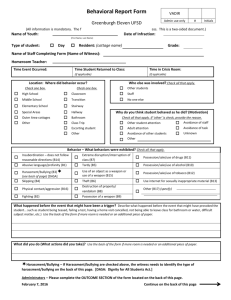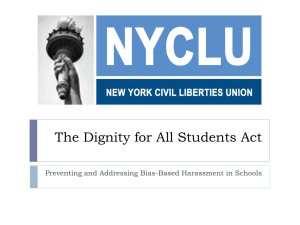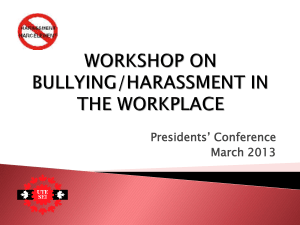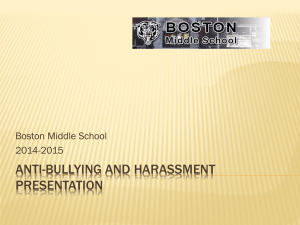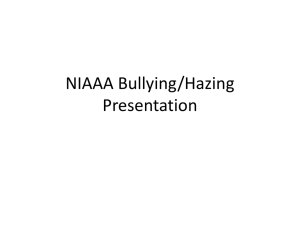Introduction to School District Policy 5.002
advertisement
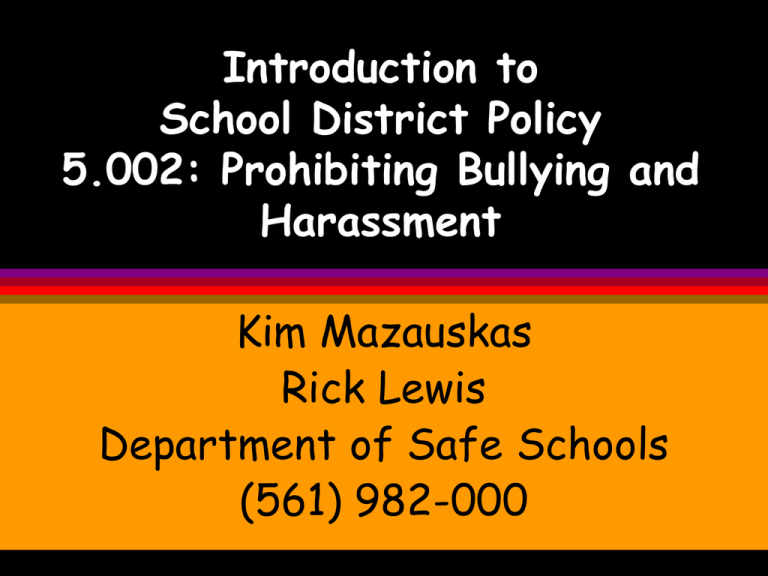
Introduction to School District Policy 5.002: Prohibiting Bullying and Harassment Kim Mazauskas Rick Lewis Department of Safe Schools (561) 982-000 Purpose of this Vodcast Provide you with information on the requirements of the: “Jeffrey Johnston “Stand Up For All Students Act” New School Board Policy 5.002 Direct you to additional resources 2 Requirements of the Law Definition of bullying and harassment Intervention processes and time frames Publication of policy and requirements for anonymous reporting systems Mandated education for staff 3 Definition of Bullying “Bullying means systematically and chronically inflicting physical hurt or psychological distress on one or more students or employees.” 4 Definition of Bullying, con’t. “unwanted and repeated written, verbal, or physical behavior, including any threatening, insulting, or dehumanizing gesture, by an adult or a student, that is severe or pervasive enough to create an intimidating, hostile, or offensive educational environment; to cause discomfort or humiliation; or unreasonably interfere with the individual’s school performance or participation.” 5 “It may involve, but is not limited to:” (Unwanted) teasing Social exclusion Threat Sexual, religious, or racial/ethnic harassment Public humiliation Damaging or Destruction of property Intimidation Stalking Physical violence Theft Placing a student in reasonable fear of harm to his or her person or property Cyberbullying Cyber-stalking 6 Characteristics of Bullying Was the behavior committed intentionally to inflict harm on the other? Was there an imbalance in the physical, social, or emotional power between the students? Was the behavior inflicted repeatedly? Is there a pattern to this behavior or situation? 7 Olweus Clip 8 Recognizing Bullying Physical Aggression pushing, shoving, hitting, kicking, defacing property, stealing, demeaning and humiliating, locking up, violence against family/friends, using weapons, inflicting bodily harm 9 Recognizing Bullying Verbal Aggression mocking, name calling, taunting, teasing (clothes, appearance), verbal threats against property, possessions, verbal threats of violence or of inflicting bodily harm 10 Recognizing Bullying Intimidation threatening to reveal personal information, graffiti, publicly challenging, defacing property or clothing, taking possessions, extortion, coercion, threatening with a weapon 11 Recognizing Bullying Social Alienation gossiping, embarrassing, rumors, ethnic slurs, public humiliation, exclusion, social rejection, malicious and premeditative behaviors, rumor mongering, threatening total isolation 12 Cyber-bullying and Cyber-stalking “Use of electronic communication or technological devices to include, but not be limited to, e-mail messages, instant messaging, text messaging, cellular telephone communication, internet blogs, social websites, internet chat rooms, internet postings, digital pictures or images, and defamatory websites to engage in acts of bullying and harassment.” 13 New addition re: cyber-bullying “The physical location or time of access of a computerrelated incident cannot be raised as a defense in any disciplinary action initiated under this section.” 14 What is Harassment? Harassment: Threatening, insulting, or dehumanizing gesture, use of computers, or written, verbal,or physical conduct directed against a student or school employee that causes reasonable fear of harm to person or property; substantially interferes with a student’s educational performance,opportunities, or benefits; or substantially disrupts the orderly operation of a school. Also includes cyber-bullying. Adult reporting number: (561) 357-5999 15 Costs: For Victims Low self-concept Depression Anxiety Somatic complaints Social withdrawal, isolation and nonacceptance Absenteeism Aggression Loss of Hope 16 Costs: For Aggressors Moral disengagement Delinquency Early alcohol use Drug use Sexual harassment Correlation with imprisonment 17 If you should come across bullying/harassing behavior: Never ignore a situation that involves intimidation. Immediately interrupt the bullying or harassing comments and/or behavior on the spot! Model respectful verbal and body language Make it clear that the behavior is unacceptable and it violates school and workplace policy • Name and identify the behavior(s). • Label the specific behavior you witnessed, and repeat the specific words you heard and use them. 18 If you should come across bullying/harassing behavior, take these steps: Support the victimized student(s) and/or colleague to regain self-control and save face. Address the behavior in front of all the bystanders. Don’t allow the aggressor to make excuses. Determine the severity of the incident. Assess the safety of all the participants. Determine if this incident has the potential to continue and/or escalate. Inform administrators unless you have reason to believe the incident was truly minor. Follow up in private with all involved. 19 New requirements Must include this policy in adult and student handbooks Must post notices Must establish anonymous reporting methods • Assign a school phone number to be checked for messages • Secondary schools: drop boxes? 20 Resource Guide Go on http://safeschools.palmbeach. k12.fl.us/bullying 21 Protecting Students National School Board Association “Research indicates that creating a supportive school climate is the most important step in preventing harassment. A school can have policies and procedures, but those alone will not prevent harassment. Good preventive and proactive mindset is what we need to help ensure that our schools provide a safe and welcomed environment for all students.” 22



